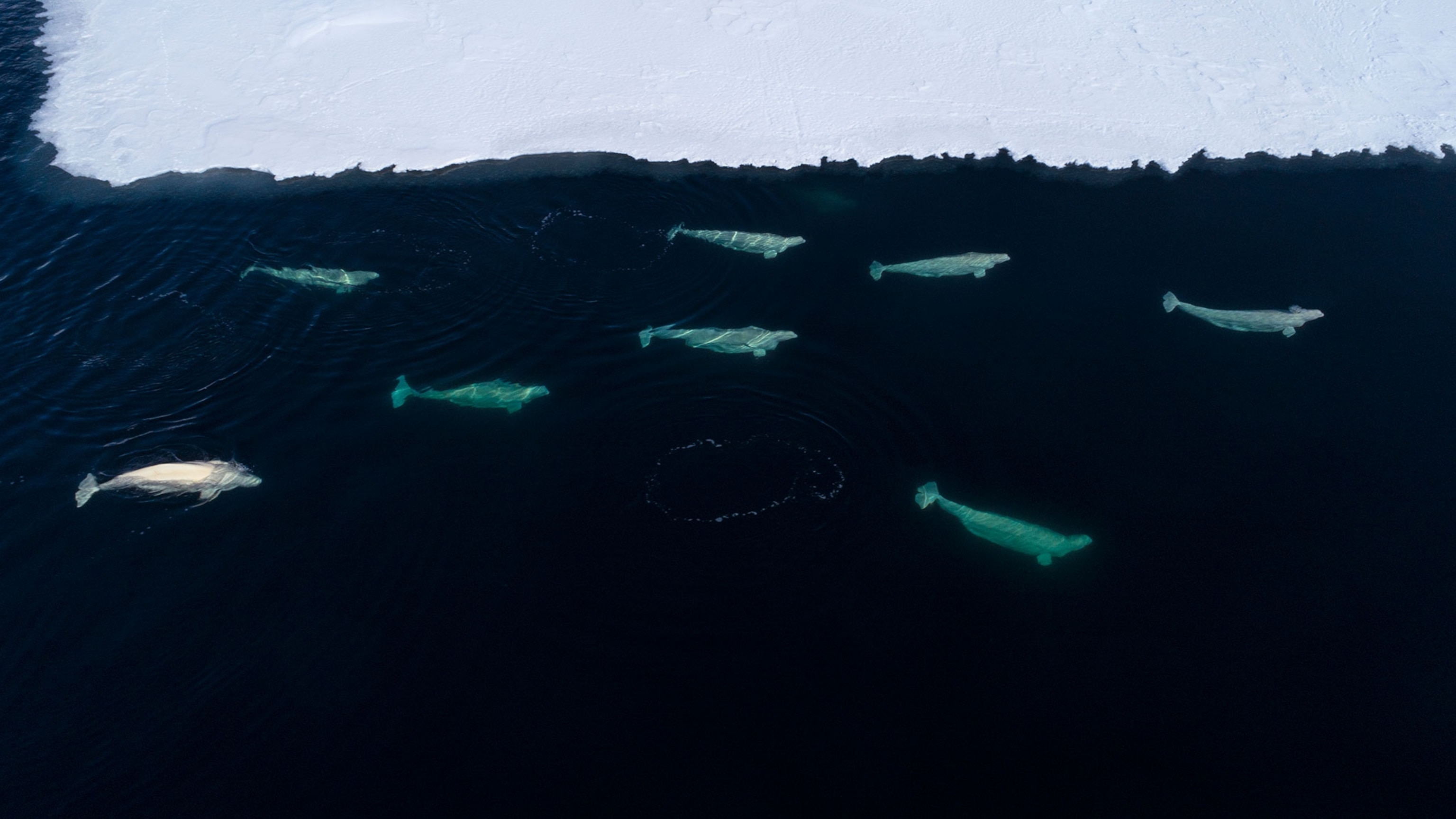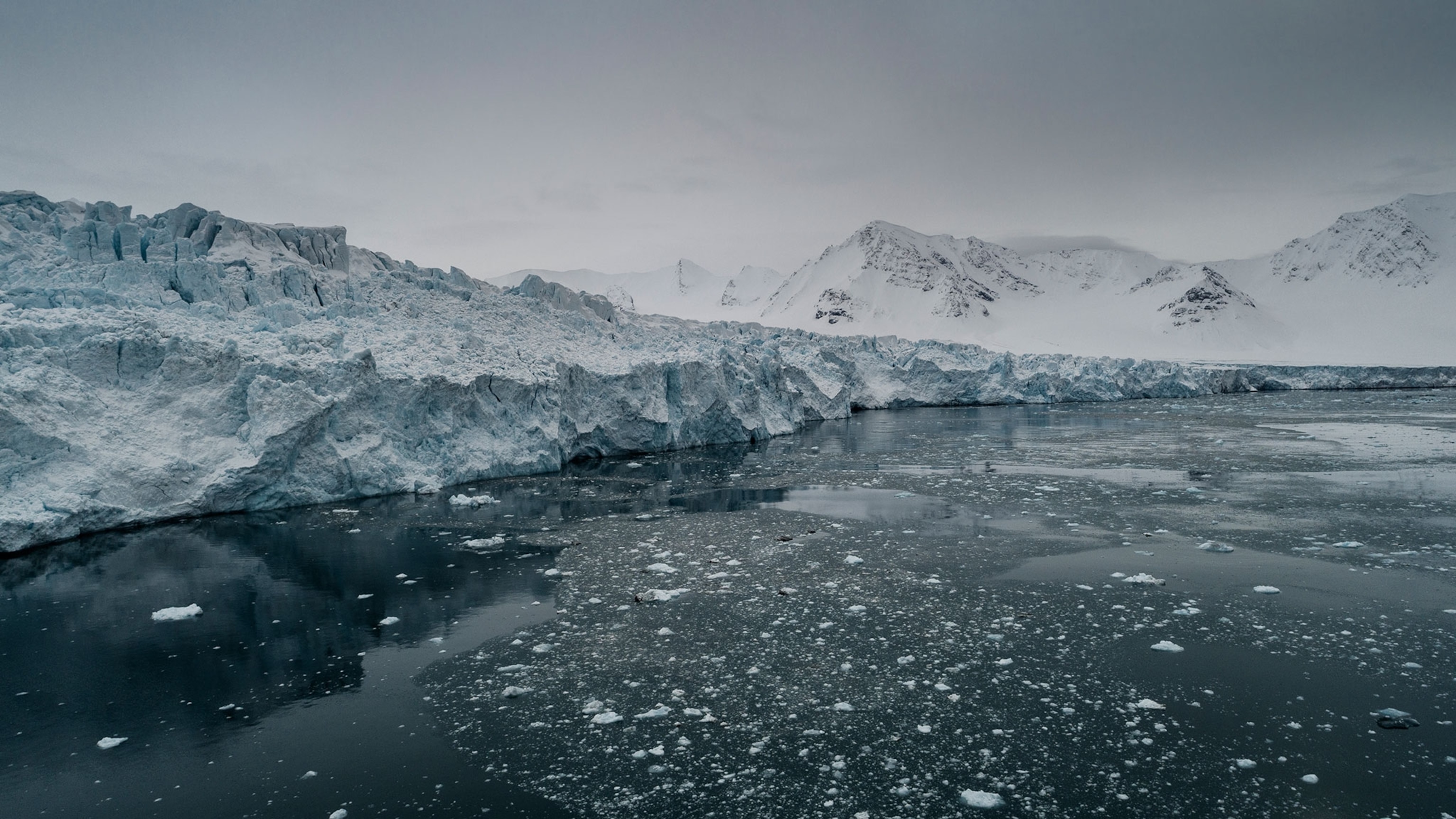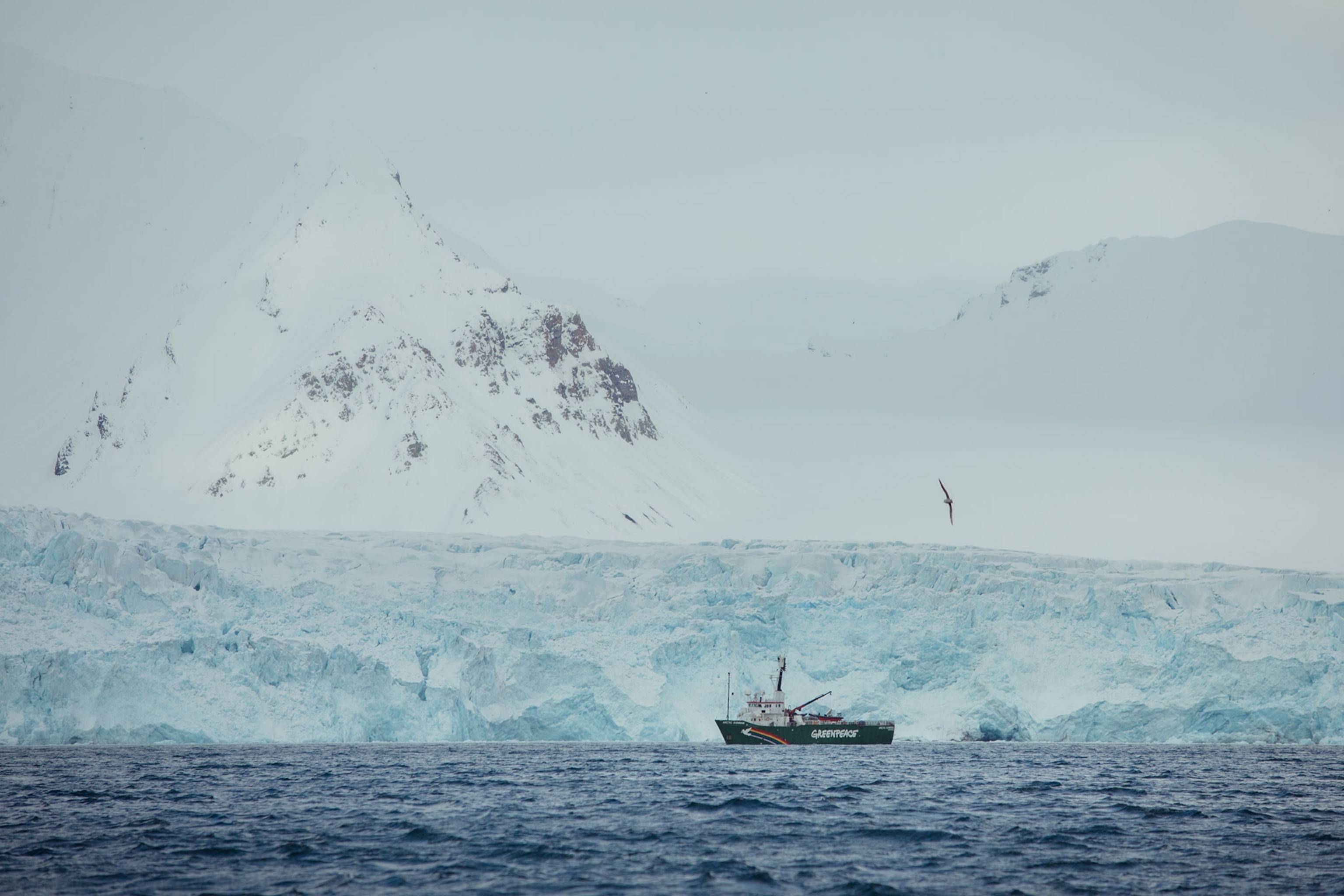
Melting ice may be a boon for some Arctic whales—then a bust
As sea ice vanishes, so do the fatty algae that live inside it. They're the rich base of a food chain that runs from plankton to whales.
On a bright May morning, a helicopter lifts off the Esperanza, a Greenpeace ship, and heads north, tracking the edge of the sea ice east of Greenland. Below us is Fram Strait, a deep ocean channel and one of the Arctic’s richest feeding grounds, where narwhals, bowhead whales, and beluga whales gather each spring to feast at the ice edge.
We’re on the lookout for these ocean giants. It’s day three of a two-week expedition, and so far, there’s no sign of any whales. Already, the sea ice is melting, releasing some of the richest fare on offer in the frozen Arctic: ice algae, specialist life forms that live in water pockets at the bottom of the ice. Animal plankton will eat them, and they in turn will become food for bowheads as well as for fish and squid, which are staples in the diets of narwhals and beluga whales.

“Whales don’t eat the algae, but they do eat the stuff that eats the algae,” says Hillary Glandon, a whale biologist from the University of North Carolina Wilmington.
Like the rest of the Arctic, Fram Strait is changing fast, and Glandon is one of a team of scientists now trying to figure out what that means for the whales that time their visits to dine on the region’s sumptuous spring feast. The expedition, involving two ships, is the first leg of an 11-month, Greenpeace-funded, pole-to-pole voyage to highlight the need to protect the high seas, outside territorial waters.
In the past 30 years, plankton-eating baleen whales–humpbacks, fins and minkes–have begun to venture into parts of the Arctic such as the Chukchi Sea, between Alaska and Siberia, where sea ice has retreated and plankton are flourishing in the sunlit waters. According to one forecast, the waters off northern Siberia in particular may grow increasingly productive over the course of this century, as the planet continues to warm.
Fram Strait is more complicated. Caught between the deep waters of the Arctic and Atlantic, it’s experiencing climate change from both directions. The sea ice drifting into Fram Strait from the north has thinned—by as much as 30 percent in 15 years—but it’s still here in abundance, and it’s being melted by ever warmer waters drifting in from the south. For now, there’s an even richer banquet of nutritious ice algae on offer for any whale that manages to partake. “In the short term a surplus of food is good,” says Glandon.
But this boom is unlikely to last. The entire region could be ice-free in summer within 20 years. “Once the ice goes, the algae goes,” says Glandon. The question is what happens then to the rest of the ecosystem.
(Read about how even polar bears depend on ice algae.)
Bad food, slow service
Unlike phytoplankton, the microscopic algae that float in open water and blossom in the sunshine, sea-ice algae are adapted to living in low-light conditions. Trapped in extremely salty, cold pockets of water near the bottom of the ice, these algae “are like the shadow plants of a forest. They thrive in the half-light,” says Ilka Peeken, a polar biologist at the Alfred Wegener Institute in Bremerhaven, Germany.
To survive, they’ve had to adapt. “Everyone has to use some insulation to survive here,” says Peeken. “Just like the seals and whales, the algae produce lipids—they put on some fat—to protect themselves.”
As the Arctic ice recedes, allowing more light to hit the sea surface, it will fuel blooms of phytoplankton. In the short term, the overall mass of microscopic plants should rise in some parts of Fram Strait.
The problem is, phytoplankton are much less fatty and nutritious than ice algae. “Potentially we are moving from a luxury food item to a fast food item,” says Thomas Brown, a marine ecologist at the Scottish Association for Marine Science in Argyll, Scotland. “It’s like having access to nice restaurants in your neighbourhood. If something happens and they close, you’re left with a few crappy fast food chains. That affects body condition.”
What’s more, it’s not just the quality of food that’s important, it’s also the timing. Being tolerant of low light, the ice algae grow rapidly early in the year, before the phytoplankton are blooming. Many species, such as copepods—tiny animal plankton—time their arrival and the birth of their young to coincide with the spring thaw, when ice algae are released into the ocean.

“If you have an animal that’s expecting its meal to be put on the table at a particular time, and that doesn’t happen, that can have a catastrophic effect. How will it feed its young? How will it reproduce?” asks Brown.

Without the ice, there’s likely to be less food available in the Arctic throughout the whole year, says Mattias Cape, a biological oceanographer at the University of Washington and one of the Arctic research team. “If you remove all the sea ice from the Arctic, what you’re left with is a surface layer that will keep warming,”
With a warm top layer, the ocean mixes less, and fewer plant nutrients like nitrogen and phosphorus reach the surface from the ocean’s depths. Without a constant supply of nutrients, phytoplankton can’t continue to grow. Typically, in an ice-free Arctic there will be one big phytoplankton bloom and then little to follow.
“For us, if we had one meal—a really nutritious breakfast— that would be great, but we’d be struggling the next day if we didn’t have lunch or dinner,” says Cape. “So, if you have one pulse of productivity in April or May, but then very little food for the rest of the year, that’s a concern.”
Dicey future
In a makeshift lab on board the Arctic Sunrise, the second Greenpeace ship, Glandon peers down a microscope at a bunch of copepods. Some of them are literally stuffed with green ice algae or visible oil sacs—little yellow lipid parcels they accumulate by feeding on the fatty algae.
To compound the problem of there being fewer ice algae as sea ice disappears, the copepods have faster metabolisms at higher water temperatures and thus burn through their oil sacs more quickly—further reducing food quality for larger predators like whales. How well predators cope with these changing conditions will depend on whether they can switch between foods.
“There will be winners and losers,” says Heather Koopman, another member of the Arctic team and a whale biologist at the University of North Carolina in Wilmington. “Some animals will show flexibility in their feeding behaviour and will do well.”
Belugas and narwhals, for example, are opportunistic feeders that can eat a large variety of fish and crustaceans. For baleen whales, switching diet is much harder. Minke and fin whales have short, coarse baleen, which is ideal for eating large fish and krill. Bowheads, on the other hand, have longer, fine baleen, specifically adapted to eating copepods and unsuitable for eating fish. They may suffer most.
“But life is not just about eating—it’s also about getting through the rest of your day,” says Koopman. Narwhals, for example, hide under the sea ice to seek refuge from killer whales.
On day seven of the expedition, our pilot, Martin, takes us a full 50 miles north of the ships, to where the ice floes turn to solid pack ice. We spot polar bear tracks in the snow and the occasional fulmar or ivory gull riding the breeze. Still no whales.
In the 17th Century, before whaling decimated the population, bowheads numbered more than 50,000 adults in Fram Strait. They were so abundant that simply by eating and excreting in these nutrient-rich waters, they helped to fertilize the ocean depths, here and elsewhere.
“Today, there are so few whales left that we don’t think of them as being important at the level of trees or bugs, but in the past—when they were abundant—they had a vital role in ocean health,” says Alyson Fleming, a whale biologist on the North Carolina team.
Whaling disrupted the ecological cycle in these waters, and now global warming is doing it again. Scientists estimate that only around 100 bowhead whales are left near Fram Strait, which may explain our difficulty in finding them.
“It’s like looking for a needle in a haystack,” says Koopman, who finally saw a large pod of around 30 belugas, after I’d left.
For the whales that feed here, the future is dicey. Says Glandon: “If you lose the ice, the whole system falls apart.”







